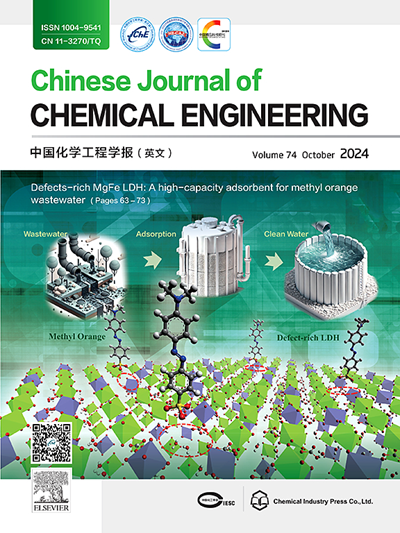Enhanced electrochemical nitrate removal from groundwater by simply calcined Ti nanopores with modified surface characters
IF 3.7
3区 工程技术
Q2 ENGINEERING, CHEMICAL
引用次数: 0
Abstract
A simple and convenient preparation method with high catalytic reduction activity is crucial for the remediation of nitrate contamination. In this study, the innovation for fabricating a nanoelectrode was developed by calcinating the anodized plate to alter the surface crystalline phase of the material. The prepared calcined Ti nanopores (TNPs) electrode could effectively remove up to 95.1% nitrate from simulated groundwater at 30 mA·cm–2 electrolysis for 90 min, while under the same conditions, the removal efficiency of nanoelectrode prepared by conventional methods was merely 52.5%. Scanning electron microscopy images indicated that the calcined TNP nanoelectrode was porous with different pore sizes. The higher nitrate removal efficiency of TNPs-500 (95.1%) than TNPs-400 (77.5%) and TNPs-550 (93.4%) may resulted from the positive nonlinear response of the larger electrochemical active surface area, the improved electron transfer and suitable surface structure, and not the “anatase-to-rutile” of surface TiO2 nanotubes. After 90 min of electrolysis, using RuO2 as an anode and adding 0.3 g·L−1 NaCl solution, 87.5% nitrate was removed, and the by-products (ammonia and nitrite) were negligible. Increased temperature and alkaline conditions can enhance the nitrate removal, while higher initial nitrate concentration only improved the nitrate removal slightly. Moreover, The TNPs-500 electrode also exhibited excellent nitrate removal performance in real groundwater with the efficiency at 82.9% and 92.1% after 90 and 120 min, which were 0.87 (removal efficiency = 95.1%), 0.92 (removal efficiency = 100%) of the efficiency for simulated groundwater, indicating the widely applicable conditions of the TNPs-500 electrode. This approach of surface-bonded elements and structure modification through calcination significantly improves catalytic activity and will guide the simple designing of functional nanostructured electrodes with wide application conditions.
通过改变表面特征的简单煅烧钛纳米孔提高电化学去除地下水中硝酸盐的能力
一种简单方便且具有高催化还原活性的制备方法对于硝酸盐污染的修复至关重要。在这项研究中,通过煅烧阳极氧化板来改变材料的表面结晶相,创新性地制备了纳米电极。所制备的煅烧钛纳米孔(TNPs)电极在 30 mA-cm-2 的电解条件下,90 分钟可有效去除模拟地下水中 95.1% 的硝酸盐,而在相同条件下,传统方法制备的纳米电极的去除率仅为 52.5%。扫描电子显微镜图像显示,煅烧后的 TNP 纳米电极呈多孔状,孔径大小不一。TNPs-500 的硝酸盐去除率(95.1%)高于 TNPs-400(77.5%)和 TNPs-550(93.4%),这可能是由于更大的电化学活性表面积、更好的电子传递和合适的表面结构所产生的正非线性响应,而不是表面 TiO2 纳米管的 "锐钛化"。以 RuO2 为阳极,加入 0.3 g-L-1 NaCl 溶液,电解 90 分钟后,硝酸盐去除率为 87.5%,副产物(氨和亚硝酸盐)微乎其微。升高温度和碱性条件可以提高硝酸盐的去除率,而较高的初始硝酸盐浓度只能略微提高硝酸盐的去除率。此外,TNPs-500 电极在实际地下水中也表现出优异的硝酸盐去除性能,90 分钟和 120 分钟后的去除率分别为 82.9% 和 92.1%,分别是模拟地下水去除率的 0.87(去除率 = 95.1%)和 0.92(去除率 = 100%),这表明 TNPs-500 电极的适用条件非常广泛。这种通过煅烧对表面键合元素和结构进行修饰的方法显著提高了催化活性,将指导具有广泛应用条件的功能纳米结构电极的简单设计。
本文章由计算机程序翻译,如有差异,请以英文原文为准。
求助全文
约1分钟内获得全文
求助全文
来源期刊

Chinese Journal of Chemical Engineering
工程技术-工程:化工
CiteScore
6.60
自引率
5.30%
发文量
4309
审稿时长
31 days
期刊介绍:
The Chinese Journal of Chemical Engineering (Monthly, started in 1982) is the official journal of the Chemical Industry and Engineering Society of China and published by the Chemical Industry Press Co. Ltd. The aim of the journal is to develop the international exchange of scientific and technical information in the field of chemical engineering. It publishes original research papers that cover the major advancements and achievements in chemical engineering in China as well as some articles from overseas contributors.
The topics of journal include chemical engineering, chemical technology, biochemical engineering, energy and environmental engineering and other relevant fields. Papers are published on the basis of their relevance to theoretical research, practical application or potential uses in the industry as Research Papers, Communications, Reviews and Perspectives. Prominent domestic and overseas chemical experts and scholars have been invited to form an International Advisory Board and the Editorial Committee. It enjoys recognition among Chinese academia and industry as a reliable source of information of what is going on in chemical engineering research, both domestic and abroad.
 求助内容:
求助内容: 应助结果提醒方式:
应助结果提醒方式:


